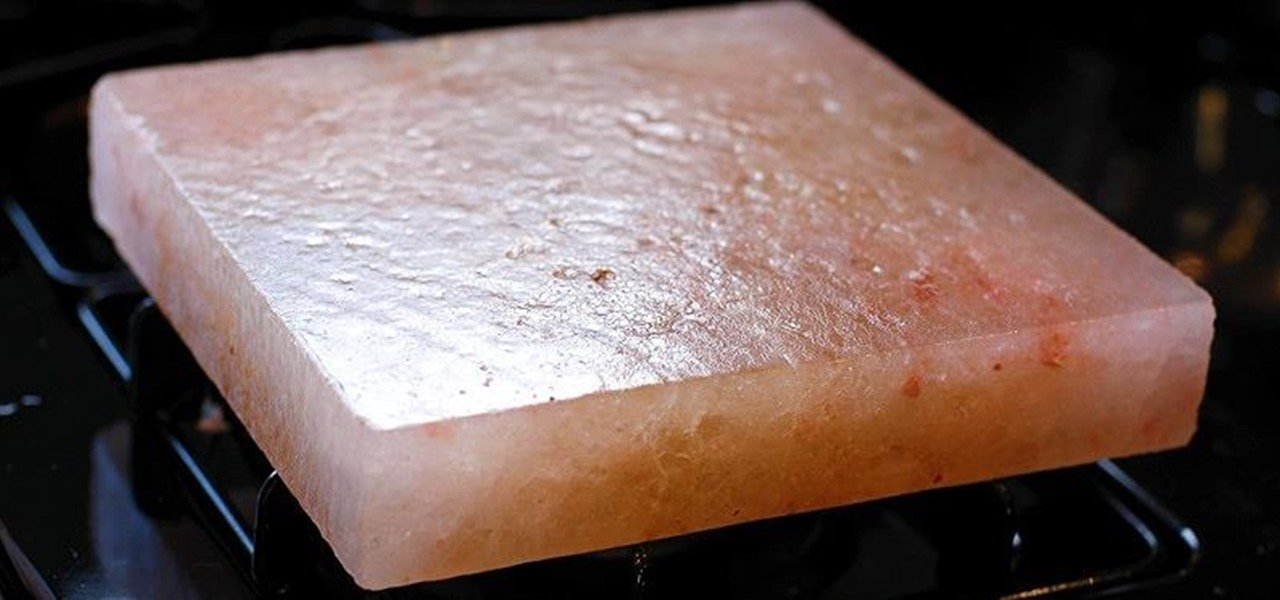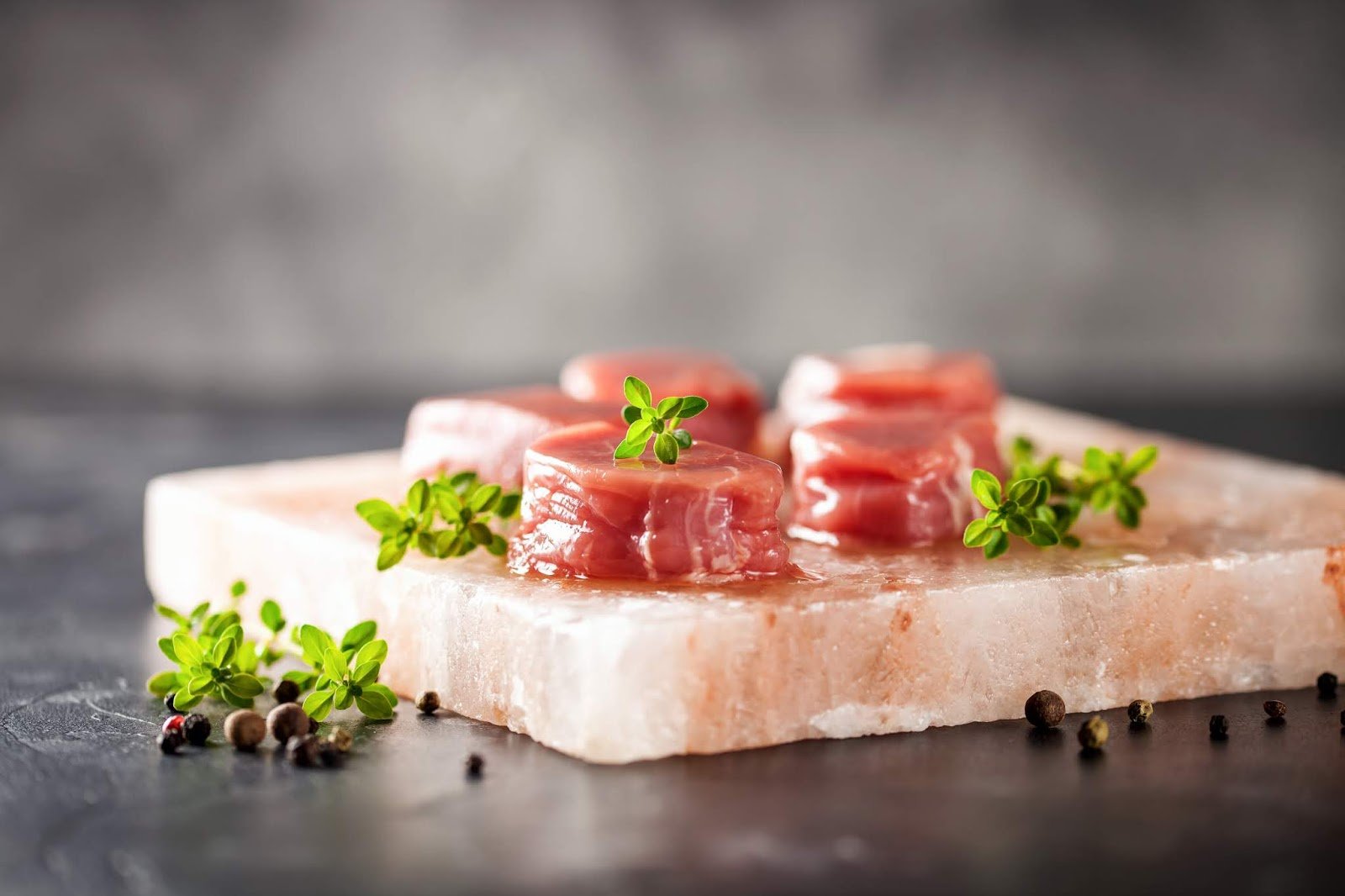A Himalayan salt block is a slab of Himalayan salt, which is similar to table salt but contains a slightly higher amount of minerals, such as potassium, iron, calcium, magnesium, and sulfur.
These extra minerals give Himalayan salt its distinctive flavor and pink color.
Slabs are mined and carved into a range of shapes and sizes. As it retains high heat for long periods, the end product can be heated in the oven or on the stovetop and used to cook foods.
Himalayan salt blocks also make visually appealing platters for various hot or cold dishes.
Slowly heat the salt slab, drop whatever you’re cooking on top and watch it sizzle. Because of the block’s unique composition imparts your food with a subtle hint of mineral saltiness that’s fantastic. It’s normal for your salt slab to form small cracks or change to a whiter color when you heat it, but if the temperature changes too quickly, it can shorten the life of your block or result in breakage. Before heating your Himalayan salt block, ensure it is dry — heating it while wet can result in a nasty break and a much shorter lifespan for your salty companion. These simple steps ensure your salt slab hits the perfect temperature without damage.
Himalayan Salt Block Cooking
On the Stove
Heating your block on a gas stovetop is one of the easiest ways to do it, so it’s an excellent place to start if you’re new to cooking on a salt slab:
- Place your salt block on the stovetop.
- Set the heat to low and let the block heat at that temperature for 15 minutes.
- Switch the heat to medium and let the block heat for another 15 minutes.
- Turn the heat high and let the block heat for another 15 minutes.
- Check the block’s temperature — you want the final temperature to be around 500 degrees. If you have an infrared thermometer on hand, you can easily use that to keep track of the temp as the block heats up. Otherwise, sprinkle a few drops of water on the block. Once it sizzles and immediately evaporates, you’re ready to start cooking.
Tip: You can still heat your salt slab properly if you have an electric stovetop; you need another tool. Place a metal ring (like a pastry or wok ring) over the burner and put the salt block on top of the ring. Then you can heat it slowly, just as you would on a gas range.

On The Grill
It’s not too tricky to grill on a salt slab. Like on the stove, the key to safely heating your block is to do it slowly.
- Place your salt slab on the grate.
- If using a charcoal grill, stack the coals on one side and heat the block on the other to keep it from heating too quickly.
- If using a gas grill, start with the heat on low and steadily increase it, cooking in 15-minute increments just as you would on the stove.
Once heated, a Himalayan salt block can be cooked for hours, so don’t waste it by only cooking a portion of your meal on it. The salt adds something different to each type of food you toss on top.
The salt slab is ideal for the flank steak as we saw it seemed more juicy than usual. In a way, cooking with salt is like immersing meat in brine. As sodium and chloride ions penetrate meat tissue, their charge mixes with proteins, making them more likely to retain moisture. Less is lost during the cooking process.
But it’s not just suitable for meat. Everything tastes better with a tiny hint of salt seared into it. Eggs cooked on the block are next-level delicious, and the subtle salt flavor provides a perfect balance to sweet fruits like watermelon, strawberries, and peaches. Generally, smaller pieces of food cook best on Himalayan salt slabs, so it will speed up your kitchen time if you slice up fruits and veggies before cooking and stick to thinner cuts of meat.
Usage, Cleaning, and Storing:
- Always cook on the same side of the salt pan. It prevents cracks from forming or worsening.
- Allow your salt block to cool completely before cleaning, then use a damp sponge or washcloth to wipe it clean, using only water — not soap.
(Don’t submerge the block in water, put it in a dishwasher, or use soap on the surface, as this can cause damage to the plate’s sensitive surface)
- After cleaning the salt block, dab it dries with a clean cloth and let it dry for 24 hours before using it again.
- Stay away from plastic utensils when cooking with Himalayan salt blocks. The intense heat of the plate is likely to damage plastic, and metal works well on salty surfaces.
- Store the salt blocks protected from moisture and humidity. Once clean, pat your block dry and set it on a drying rack. Allow it to dry completely before storing it in a cool, dry place. If you live in a humid region, try wrapping your block in a towel before putting it away.

